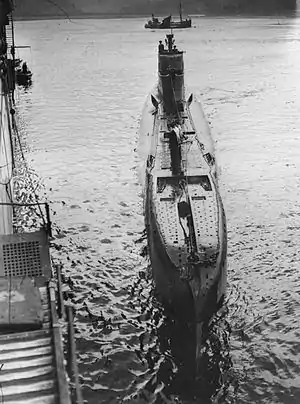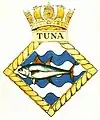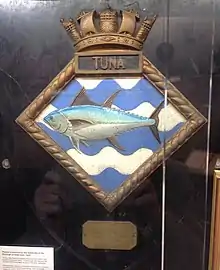HMS Tuna (N94)
HMS Tuna (N94) was a T-class submarine of the Royal Navy. She was laid down by Scotts, Greenock (in Scotland) and launched on 10 May 1940. She was equipped with German-built engines and spent her career in World War II in western European waters, in the North Sea and off the west coast of France, and most famously taking part in Operation Frankton.
 HMS Tuna approaching the submarine depot ship HMS Forth in Holy Loch (Scotland) in August 1943 | |
| History | |
|---|---|
| Name | HMS Tuna |
| Owner | Royal Navy |
| Ordered | 9 December 1937 |
| Builder | Scotts, Greenock |
| Laid down | 13 June 1938 |
| Launched | 10 May 1940 |
| Commissioned | 1 August 1940 |
| Identification | Pennant number N94 |
| Honours and awards |
|
| Fate |
|
| Badge |  |
| General characteristics | |
| Class and type | British T class submarine |
| Displacement |
|
| Length | 275 ft (84 m) |
| Beam | 26 ft 6 in (8.08 m) |
| Draught | 16.3 ft (5.0 m) |
| Propulsion |
|
| Speed |
|
| Range | 4,500 nautical miles at 11 knots (8,330 km at 20 km/h) surfaced |
| Test depth | 300 ft (91 m) max |
| Complement | 59 |
| Armament |
|
The raid on Bordeaux harbour was later dramatised in the 1955 film The Cockleshell Heroes starring Trevor Howard. Tuna also took part in many war patrols and her crew received service medals for the boat's destruction of several U-boats.
Design and description
Tuna was ordered from Scotts Shipbuilding and Engineering Company on 9 December 1937, as part of an extension of the 1937 construction programme, with an initial four submarines ordered earlier that year in July. Tuna was part of a further three boats to be ordered, along with Triad and Truant, which were obtained from another shipbuilder.[1]
She was equipped with diesel engines produced by MAN SE, a German company. The engines had been delivered before the war, and spare parts were rare, members of the crew at least once creating replacement parts from other equipment while at sea.[2]
Wartime service
Tuna had a relatively active career, serving in the North Sea and off the French and Scandinavian coasts.
Attacks on shipping and submarines
Tuna sank the 7,230-ton merchantman Tirranna on 22 September 1940. The Tirranna was a Norwegian ship that had been captured by the German armed merchant cruiser Atlantis, in the Indian Ocean. Tirranna had 292 on board when she was sunk, including at least 264 captured Allied sailors and a 16-strong German prize crew. Eighty-seven people died in the sinking, including one German.[3][4] She also torpedoed and sank the German catapult ship Ostmark and the French tug Chassiron. She fired upon and sank the German submarine U-644 and attacked the German submarine U-302 and the Italian submarine Brin as well as two unidentified submarine contacts, all unsuccessfully. An attack also failed on the German tanker Benno, formerly the Norwegian Ole Jacob, which had also been captured earlier by the Atlantis.[5]
In January 1941 Tuna and the submarine Snapper were escorted by the captured French minesweeper La Capricieuse as far as Bishop Rock, Isles of Scilly. Snapper left for a different patrol area and was presumed lost after she failed to return.[6][7] Later that month Tuna engaged and pursued an unidentified surfaced U-boat at night for more than an hour. She fired the forward-mounted four-inch gun and damage was noted to the U-boat's conning tower. The German vessel returned the fire with an aft-mounted gun, but no damage was reported by Tuna. The pursuit was called off after more enemy vessels appeared, Tuna diving to avoid them.[8]
In February 1942 the boat was ordered towards the Trondheim area along with HMS Trident to protect a convoy from enemy sorties from Norwegian ports. Although Tuna did not engage the enemy, Trident damaged the German cruiser Prinz Eugen.[9]
'Cockleshell' raid and decorations

On 30 November 1942, under the command of Lieutenant-Commander Dick Raikes DSO, Tuna sailed from Holy Loch, Scotland, inserting twelve Royal Marines swimmer canoeist commandos soon to become the SBS into the Gironde estuary as part of Operation Frankton (the attack on Bordeaux harbour).[10] She was to arrive on 6 December but was delayed due to bad weather and the presence of a minefield.[11] She arrived at the estuary a day late, surfacing 10 miles (16 km) from the mouth of the river.[10]
The aim of the operation was for several canoes of marines to paddle 60 miles up the Gironde to attack German ships in Bordeaux;[12] in the process of disembarking the canoes, one of the six canoes was damaged, leaving the submarine to return those marines while the remainder continued the assault.[10] The operation was a success although only Corporal Bill Sparks and Major Herbert Hasler survived.[12] The mission led to the formation of the Special Boat Service.[13] For his superb navigation and coolness under pressure, Lieutenant-Commander Dick Raikes was awarded the Distinguished Service Order,[14] and was later played by Christoper Lee in the 1955 film The Cockleshell Heroes.
Tuna returned to home waters for the first time in four war patrols on 18 November 1943. For the destruction of three U-boats during those patrols, her commanding officer, Lieutenant D. S. R. Martin, was awarded the Distinguished Service Order with two bars.[15] Additionally, the Distinguished Service Cross was awarded to Lt (E) N. Travers, and the Distinguished Service Medal to four other members of the crew including Chief Petty Officer William J Stabb [16] and Leading Seaman Dominic "Bommy" King.[17]
In August 1945, she attended the first British Navy week in a foreign port, in Rotterdam. Also there were the cruiser HMS Bellona and the destroyers Garth and Onslow. Foreign vessels included two of the Dutch Navy submarines of the T-class, Dolfijn and Zeehond.[18]
In 1942 the Borough of Aldershot adopted the Tuna as part of the Warship Week campaign.
Post war
Tuna survived the war and was sold to be broken up for scrap on 19 December 1945, a job carried out at one of Thos. W. Ward shipbreaking yards at Briton Ferry from June 1946.
References
- Specific
- "Submarine Construction". The Times. No. 47864. 10 December 1937. p. 27.
- Hood, Jean (2007). Submarine : an anthology of first-hand accounts of the war under the sea, 1939-1945. London, UK: Conway. pp. 202–203. ISBN 978-1-84486-046-3.
- Lawson, Siri Holm. "M/S Tirranna". Warsailors.com. Retrieved 24 January 2010.
- Lawson, Siri Holm. "Norwegian Victims of Atlantis". Warsailors.com. Retrieved 24 January 2010.
- HMS Tuna, Uboat.net
- Barnett, John (2011). The Sea Is My Grave. Bloomington, IN: Xlibris Corp. p. 62. ISBN 978-1-4628-9040-8.
- "Submarine Losses to Present Day - Day 8". Royal Navy Submarine Museum. Archived from the original on 25 July 2011. Retrieved 12 October 2011.
- "U-Boat Shelled by Submarine". The Times. No. 48819. 9 January 1941. p. 4.
- O'Connell, John F (2011). Submarine operational effectiveness in the 20th century : 1939 - 1945 (Part 2). Bloomington, IN: iUniverse. p. 105. ISBN 978-1-4620-4257-9.
- Rees, Quentin (2008). The Cockleshell Canoes. Stroud, Gloucestershire, UK: Amberley. p. 76. ISBN 978-1-84868-065-4.
- Cohen, William A (2005). Secrets of Special Ops Leadership. New York, NY: Amacom. p. 93. ISBN 978-0-8144-0840-7.
- Horsnell, Michael (16 February 1983). "'Cockleshell Heroes' to have memorial 40 years after exploits". The Times. No. 61458. p. 3.
- Collins, Nick (1 April 2011). "New monument for Cockleshell Heroes". The Telegraph. Archived from the original on 4 April 2011. Retrieved 12 October 2011.
- Ashdown, Paddy (16 September 2012). "Paddy Ashdown's Cockleshell Heroes: an exclusive extract". The Telegraph. Retrieved 22 April 2016.
- "H.M.S. Tuna Home". The Times. No. 49707. 19 November 1943. p. 2.
- "Naval Awards". The Times. No. 49693. 3 November 1943. p. 2.
- "Naval decorations awarded to personnel below officer rank or Merchant Navy (MN) personnel 1939-1945". Retrieved 5 June 2016.
- "British Navy Week in Rotterdam". The Times. No. 50223. 17 August 1945. p. 6.
- General
- Colledge, J. J.; Warlow, Ben (2006) [1969]. Ships of the Royal Navy: The Complete Record of all Fighting Ships of the Royal Navy (Rev. ed.). London: Chatham Publishing. ISBN 978-1-86176-281-8.
- Hutchinson, Robert (2001). Jane's Submarines: War Beneath the Waves from 1776 to the Present Day. London: HarperCollins. ISBN 978-0-00-710558-8. OCLC 53783010.